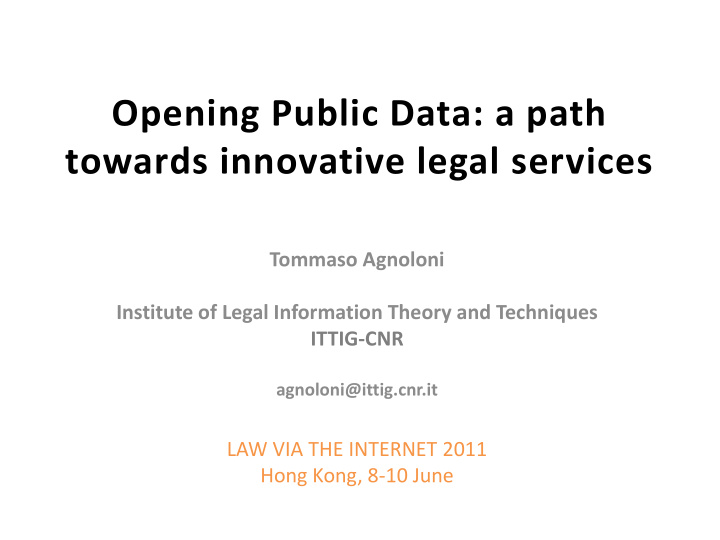



Opening Public Data: a path towards innovative legal services Tommaso Agnoloni Institute of Legal Information Theory and Techniques ITTIG-CNR agnoloni@ittig.cnr.it LAW VIA THE INTERNET 2011 Hong Kong, 8-10 June
The “Open” in Open Data Open Data is about data re-use “A piece of content or data is open if anyone is free to use, reuse, and redistribute it — subject only, at most, to the requirement to attribute and share- alike.” . The Open Knowledge Definition (OKD) (opendefinition.org/okd)
Make Data legally open • Use existing licensing: Public Domain (no rights reserved) – Public Domain Dedication & License (PDDL) – Creative Commons Zero (CC0) Attribution (you must give credit) – Open Data Commons Attribution (ODC-BY) – Creative Commons Attribution (CC-BY) ‘Sharealike’ (you must share back) – Open Data Commons Attribution-Sharealike (ODbL) – Creative Commons Attribution Sharealike (CC-BY-SA) • Or create your own license
Make Data technically open Raw Data - separate informative content from presentation • Use open formats (txt, XML, html, odt) • use URIs for identification • expose the data for access via the HTTP protocol • use the RDF data model to describe content of resources and to link them to other useful information (Machine Readable METADATA)
RDF Data Model • Provides the missing relational level • simple data model based on triples • Statements are <subject, predicate, object> triples: – <Book X, hasAuthor, Author Y> • Can be represented as a graph : hasAuthor Book X Author Y • Statements describe properties of resources • A resource is any object that can be pointed to by a URI : • The subject of one statement can be the object of another A collection of statements creates a directed labeled graph • Resources available distributed on the web
From a Web of Documents to a Web of Data Establish machine readable meaningful links among resources on the web of data just like hyperlinks connect html documents on the web of documents 2007 2011
Motivations for open PSI • Transparency • Economic value • Accountability • EUROPEAN PSI is estimated to worth • Public control of € 27 billion government • Added value on data • Engagement / (metadata) participation / • Apps/Services fed by democracy publicly available • More efficient use of data - new market public resources
Towards a Legal Data Cloud EU Legal Sources
Legal Information Access • Legal sources fragmentation “To a worryingly large extent, statutory law is not practically accessible today, even to the courts whose constitutional duty it is to interpret and enforce it. There are four principal reasons. … First, the majority of legislation is secondary legislation. … Secondly, the volume of legislation has increased very greatly over the last 40 years … Thirdly, on many subjects the legislation cannot be found in a single place, but in a patchwork of primary and secondary legislation . … Fourthly, there is no comprehensive statute law database with hyperlinks which would enable an intelligent person, by using a search engine, to find out all the legislation on a particular topic. ” Lord Justice Toulson in R v Chambers [2008] EWCA Crim 2467 LINKED DATA PRINCIPLES
Legal Information Standards • URN:Lex • XML Schema (Metalex/CEN, Crown XML, NormeInRete..) • Legislative metadata model (FRBR+Metalex Cen+Dublin Core .. ) • Legal Ontologies – Core Legal Ontologies, LKIF reusable but.. TOP DOWN APPROACH lots of structure – few instances …
Reuse existing schema Linked open data approach: RAW DATA NOW! BOTTOM UP • Instances first First source of structured • Refine later information: existing • Technically databases – exposed and feasible thanks to published on the web of interoperable data according to LOD standards Principles
Interplay with semantic assets Technically interoperable thanks to web standards with: • Thesauri: EUROVOC Skos/XML – Multilingual retrieval • Legal ontologies – conceptual access; e.g. topic filtered view on data • Computational lexicons – Improved automated semantic relation
Innovative legal service • On top of the data layer • Views / Services • Integrated access by subject • Cross dataset query • Recompose fragmented sources in a single place providing services accessing distributed resources • Automated (machine readable resources)
Mash-ups LEGAL DATA “SOCIAL DATA” Legislation Case-Law Blogs Bills Comments Amendments News Proposals Social networks Votes SCIENTIFIC DATA FACTUAL DATA Literature Bibliography Trends Abstracts Statistics Doctrine Indicators
Conclusions • Open Data movement is complementary and compatible in principles with FALM • Provides viable pragmatic technical solutions to put in practice freedom of access in terms of information REUSE • Expanded community to push for public data publication freely licensed • Legal datasets in Europe increasingly open published – huge potential for innovative services
Recommend
More recommend